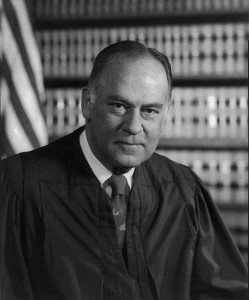
In the last edition of the Obscenity Case Files series, we discussed the Pope v. Illinois decision and how it impacted the Miller Test for identifying obscene material, which is not protected by the First Amendment. In this edition, we’ll take a look at Jacobellis v. Ohio, a decision that pre-dates Miller v. California, to shed some light on the infamous “I know it when I see it” language.
Knowing It When You See It
In his concurring opinion in the 1964 Jacobellis v. Ohio case, Supreme Court Justice Potter Stewart delivered what has become the most well-known line related to the detection of “hard-core” pornography: the infamous “I know it when I see it.” statement.

“I have reached the conclusion . . . that under the First and Fourteenth Amendments criminal laws in this area are constitutionally limited to hard-core pornography. I shall not today attempt further to define the kinds of material I understand to be embraced within that shorthand description; and perhaps I could never succeed in intelligibly doing so. But I know it when I see it, and the motion picture involved in this case is not that.”
As far as unintentionally comical lines in judicial opinions go, “I know it when I see it” is as good as it gets. The phrase immediately invokes images of black-robed Supreme Court justices pouring over pornographic magazines and screening “adult” movies, paying special attention to whether or not the materials tickle their “prurient interests.” You’d be hard pressed to find a First Amendment analyst or constitutional law professor who doesn’t have at least one “I know it when I see it” joke on hand.
Justice Stewart, the story goes, developed his eye for smut when he was stationed as a Navy lieutenant in Casablanca during World War II. While there, he had taken a gander at the locally produced pornography his men brought back to his ship. As this quote from his former law clerk shows, Stewart relied on his acquaintance with Moroccan pornography when he espoused his belief that he would know when he was seeing pornography so hard-core that it should be considered obscene:
“After several days reviewing with the other court members the materials related to the ’63 Term pornographic materials, Justice Stewart came to the office for a Saturday stint of opinion writing. I was there alone when he arrived, and we visited together to discuss his reaction to the case. . . . I had been a Marines officer; he a Navy officer. We discussed our experiences with material we had seen during our military careers, and discovered we had both seen materials we considered at the time to be pornographic, but this conclusion was arrived at somewhat intuitively. We agreed that “we know it when we see it,” but that further analysis was difficult. The justice went back to his office, and shortly thereafter produced a draft concurring opinion, which has by now become somewhat famous. I am sure he never expected, intended, or desired notoriety for this element of his work.” (source)
The Lovers
Jacobellis v. Ohio (1964) was the case Justice Stewart and his law clerk were hammering away at when they came to their “I know it when I see it” epiphanies.
Nico Jacobellis, the defendant in the case, was the manager of an art-house theater in Cleveland Heights, Ohio. Ohio authorities had taken issue with his public exhibition of the film The Lovers (Les Amants) at his theater, convicted him of criminal charges and fined him $2,500. According to Ohio authorities, The Lovers — a French film about a woman involved in adultery who rediscovers human love — contained subject matter prohibited by Ohio’s obscenity statutes. After the Supreme Court of Ohio upheld Jacobellis’ conviction, the case ended up before the U.S. Supreme Court.
The Supreme Court ultimately decided The Lovers warranted First Amendment protection and reversed Jacobellis’ conviction. The Court, however, could not agree on a rationale for determining what constituted prohibitively obscene subject matter. Despite a majority of the Justices concluding that Jacobellis’ conviction should be reversed, the Court’s final ruling was fragmented. It included one majority opinion and four concurring opinions (none supported by more than two Justices) in which each author attempted to clarify what he believed was an appropriate characterization of how the First Amendment should apply to allegedly obscene material.
The reasoning in the opinions supporting reversal ranged from Justice Hugo Black’s position that the First Amendment does not permit censorship of any kind (joined by Justice William O. Douglas) to Justice Brennan’s reluctance to conclude that The Lovers was “utterly without redeeming social importance” (joined by Justice Goldberg).
 Additionally, two justices authored dissenting opinions, indicating they favored upholding Jacobellis’ conviction. These Justices believed Ohio’s action was consistent with the Court’s prior obscenity rulings (see Roth v. United States) and that states should have “wide, but not federally unrestricted” power to ban obscene films (Chief Justice Earl Warren and Justice John Marshall Harlan II, respectively).
Additionally, two justices authored dissenting opinions, indicating they favored upholding Jacobellis’ conviction. These Justices believed Ohio’s action was consistent with the Court’s prior obscenity rulings (see Roth v. United States) and that states should have “wide, but not federally unrestricted” power to ban obscene films (Chief Justice Earl Warren and Justice John Marshall Harlan II, respectively).
By far, the most famous of the Court’s opinions was Stewart’s concurrence, which contained the “I know it when I see it” language reproduced above.
Aftermath
Post Jacobellis, the Supreme Court held a scattered position on what constituted obscene speech. It wasn’t until the 1973 Miller v. California decision and its implementation of the three-prong test for obscenity that the Court officially made the move to a more objective rationale. Although Justice Stewart’s reluctance to set a “bright line” rule for flushing out hard-core pornography was much better for the development of obscenity jurisprudence than the Court creating a list of actions or words that are per-se obscene, it is hard to see how society would benefit from select authority figures basing criminal convictions on their ability to subjectively “know when they see” unprotected speech.
Current obscenity law may not be perfect, but the Court’s adoption of an objective standard for determining a works’ merit or artistic value, rather than an “I know it when I see it” standard, benefits comic book creators and retailers. At the very least, it guarantees the relevance of the work they create and sell will not be decided based solely on what various authority figures have known or seen.
Please help support CBLDF’s important First Amendment work and reporting on issues such as this by making a donation or becoming a member of the CBLDF!
Rick Marshall is an attorney who recently finished work on a legal master’s degree in Intellectual Property law at the George Washington University Law School. Check out his musings on the intersection of music and copyright law at his website www.copynoise.com.